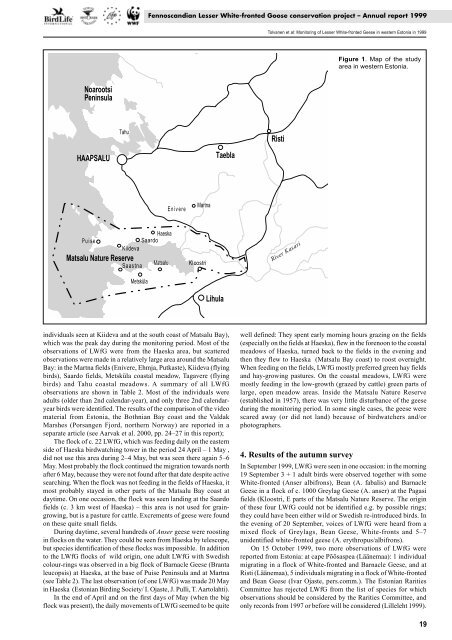Monitoring of Lesser White-fronted Geese in western Estonia ... - WWF
Monitoring of Lesser White-fronted Geese in western Estonia ... - WWF
Monitoring of Lesser White-fronted Geese in western Estonia ... - WWF
You also want an ePaper? Increase the reach of your titles
YUMPU automatically turns print PDFs into web optimized ePapers that Google loves.
Noarootsi<br />
Pen<strong>in</strong>sula<br />
HAAPSALU<br />
Puise<br />
Tahu<br />
Matsalu Nature Reserve<br />
Haeska<br />
Saardo<br />
Kiideva<br />
Saastna<br />
Metsküla<br />
Fennoscandian <strong>Lesser</strong> <strong>White</strong>-<strong>fronted</strong> Goose conservation project – Annual report 1999<br />
Enivere<br />
Martna<br />
Matsalu Kloostri<br />
Lihula<br />
Taebla<br />
<strong>in</strong>dividuals seen at Kiideva and at the south coast <strong>of</strong> Matsalu Bay),<br />
which was the peak day dur<strong>in</strong>g the monitor<strong>in</strong>g period. Most <strong>of</strong> the<br />
observations <strong>of</strong> LWfG were from the Haeska area, but scattered<br />
observations were made <strong>in</strong> a relatively large area around the Matsalu<br />
Bay: <strong>in</strong> the Martna fields (Enivere, Ehmja, Putkaste), Kiideva (fly<strong>in</strong>g<br />
birds), Saardo fields, Metsküla coastal meadow, Tagavere (fly<strong>in</strong>g<br />
birds) and Tahu coastal meadows. A summary <strong>of</strong> all LWfG<br />
observations are shown <strong>in</strong> Table 2. Most <strong>of</strong> the <strong>in</strong>dividuals were<br />
adults (older than 2nd calendar-year), and only three 2nd calendaryear<br />
birds were identified. The results <strong>of</strong> the comparison <strong>of</strong> the video<br />
material from <strong>Estonia</strong>, the Bothnian Bay coast and the Valdak<br />
Marshes (Porsangen Fjord, northern Norway) are reported <strong>in</strong> a<br />
separate article (see Aarvak et al. 2000, pp. 24–27 <strong>in</strong> this report);<br />
The flock <strong>of</strong> c. 22 LWfG, which was feed<strong>in</strong>g daily on the eastern<br />
side <strong>of</strong> Haeska birdwatch<strong>in</strong>g tower <strong>in</strong> the period 24 April – 1 May ,<br />
did not use this area dur<strong>in</strong>g 2–4 May, but was seen there aga<strong>in</strong> 5–6<br />
May. Most probably the flock cont<strong>in</strong>ued the migration towards north<br />
after 6 May, because they were not found after that date despite active<br />
search<strong>in</strong>g. When the flock was not feed<strong>in</strong>g <strong>in</strong> the fields <strong>of</strong> Haeska, it<br />
most probably stayed <strong>in</strong> other parts <strong>of</strong> the Matsalu Bay coast at<br />
daytime. On one occasion, the flock was seen land<strong>in</strong>g at the Saardo<br />
fields (c. 3 km west <strong>of</strong> Haeska) – this area is not used for gra<strong>in</strong>grow<strong>in</strong>g,<br />
but is a pasture for cattle. Excrements <strong>of</strong> geese were found<br />
on these quite small fields.<br />
Dur<strong>in</strong>g daytime, several hundreds <strong>of</strong> Anser geese were roost<strong>in</strong>g<br />
<strong>in</strong> flocks on the water. They could be seen from Haeska by telescope,<br />
but species identification <strong>of</strong> these flocks was impossible. In addition<br />
to the LWfG flocks <strong>of</strong> wild orig<strong>in</strong>, one adult LWfG with Swedish<br />
colour-r<strong>in</strong>gs was observed <strong>in</strong> a big flock <strong>of</strong> Barnacle <strong>Geese</strong> (Branta<br />
leucopsis) at Haeska, at the base <strong>of</strong> Puise Pen<strong>in</strong>sula and at Martna<br />
(see Table 2). The last observation (<strong>of</strong> one LWfG) was made 20 May<br />
<strong>in</strong> Haeska (<strong>Estonia</strong>n Bird<strong>in</strong>g Society/ I. Ojaste, J. Pulli, T. Aartolahti).<br />
In the end <strong>of</strong> April and on the first days <strong>of</strong> May (when the big<br />
flock was present), the daily movements <strong>of</strong> LWfG seemed to be quite<br />
Tolvanen et al: <strong>Monitor<strong>in</strong>g</strong> <strong>of</strong> <strong>Lesser</strong> <strong>White</strong>-<strong>fronted</strong> <strong>Geese</strong> <strong>in</strong> <strong>western</strong> <strong>Estonia</strong> <strong>in</strong> 1999<br />
Risti<br />
River Kasari<br />
Figure 1. Map <strong>of</strong> the study<br />
area <strong>in</strong> <strong>western</strong> <strong>Estonia</strong>.<br />
well def<strong>in</strong>ed: They spent early morn<strong>in</strong>g hours graz<strong>in</strong>g on the fields<br />
(especially on the fields at Haeska), flew <strong>in</strong> the forenoon to the coastal<br />
meadows <strong>of</strong> Haeska, turned back to the fields <strong>in</strong> the even<strong>in</strong>g and<br />
then they flew to Haeska (Matsalu Bay coast) to roost overnight.<br />
When feed<strong>in</strong>g on the fields, LWfG mostly preferred green hay fields<br />
and hay-grow<strong>in</strong>g pastures. On the coastal meadows, LWfG were<br />
mostly feed<strong>in</strong>g <strong>in</strong> the low-growth (grazed by cattle) green parts <strong>of</strong><br />
large, open meadow areas. Inside the Matsalu Nature Reserve<br />
(established <strong>in</strong> 1957), there was very little disturbance <strong>of</strong> the geese<br />
dur<strong>in</strong>g the monitor<strong>in</strong>g period. In some s<strong>in</strong>gle cases, the geese were<br />
scared away (or did not land) because <strong>of</strong> birdwatchers and/or<br />
photographers.<br />
4. Results <strong>of</strong> the autumn survey<br />
In September 1999, LWfG were seen <strong>in</strong> one occasion: <strong>in</strong> the morn<strong>in</strong>g<br />
19 September 3 + 1 adult birds were observed together with some<br />
<strong>White</strong>-<strong>fronted</strong> (Anser albifrons), Bean (A. fabalis) and Barnacle<br />
<strong>Geese</strong> <strong>in</strong> a flock <strong>of</strong> c. 1000 Greylag <strong>Geese</strong> (A. anser) at the Pagasi<br />
fields (Kloostri, E parts <strong>of</strong> the Matsalu Nature Reserve. The orig<strong>in</strong><br />
<strong>of</strong> these four LWfG could not be identified e.g. by possible r<strong>in</strong>gs;<br />
they could have been either wild or Swedish re-<strong>in</strong>troduced birds. In<br />
the even<strong>in</strong>g <strong>of</strong> 20 September, voices <strong>of</strong> LWfG were heard from a<br />
mixed flock <strong>of</strong> Greylags, Bean <strong>Geese</strong>, <strong>White</strong>-fronts and 5–7<br />
unidentified white-<strong>fronted</strong> geese (A. erythropus/albifrons).<br />
On 15 October 1999, two more observations <strong>of</strong> LWfG were<br />
reported from <strong>Estonia</strong>: at cape Põõsaspea (Läänemaa): 1 <strong>in</strong>dividual<br />
migrat<strong>in</strong>g <strong>in</strong> a flock <strong>of</strong> <strong>White</strong>-<strong>fronted</strong> and Barnacle <strong>Geese</strong>, and at<br />
Risti (Läänemaa), 5 <strong>in</strong>dividuals migrat<strong>in</strong>g <strong>in</strong> a flock <strong>of</strong> <strong>White</strong>-<strong>fronted</strong><br />
and Bean <strong>Geese</strong> (Ivar Ojaste, pers.comm.). The <strong>Estonia</strong>n Rarities<br />
Committee has rejected LWfG from the list <strong>of</strong> species for which<br />
observations should be considered by the Rarities Committee, and<br />
only records from 1997 or before will be considered (Lilleleht 1999).<br />
19



